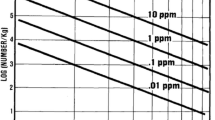Abstract
Because aluminum alloy castings are becoming commonplace for critical applications in the automotive and aerospace industries, tight control over the cleanliness of the melt (mitigation of solid particle inclusions) and microstructure must be achieved. In order to control cleanliness, it must first be well defined and measured. Very few techniques exist in industry that can quantitatively measure inclusion levels in-situ. Laser-induced breakdown spectroscopy (LIBS) is presented as a promising technique to quantify solid particles, desired or undesired, in aluminum melts. By performing LIBS with subsequent statistical analysis on liquid Al with varying amounts of TiB2 particles, calibration curves for B and Ti were generated.
Access this chapter
Tax calculation will be finalised at checkout
Purchases are for personal use only
Preview
Unable to display preview. Download preview PDF.
Similar content being viewed by others
References
S. Poynton, M. Brandt, and J. Grandfield, “A Review of Inclusion Detection Methods in Molten Aluminium,” (Paper Presented at Light Metals 2009, 138th TMS Annual Meeting, San Fransisco, CA, 15–19 February 2009), 681–687.
J. Wannasin, D. Schwam, and J.F. Wallace, “Evaluation of Methods for Metal Cleanliness Assessment in Die Casting,” Journal of Materials Processing Technology, 191 (3) (2007). 242–246.
T.A. Utigard and I.D. Sommerville, “Cleanliness of Aluminum and Steel: A Comparison of Assessment Methods,”(Paper Presented at Light Metals 2005, 134th TMS Annual Meeting, San Fransisco, California, 13–17 February 2005), 951–956.t
O. Lashkari et al., “X-Ray Microtomographic Characterization of Porosity in Aluminum Alloy A356,“ Metallurgical and Materials Transactions A, 40 (4) (2009), 991–999.
D. Neff, “Using Filters and Evaluating Their Effectiveness in High Pressure Diecasting,” (Paper presented at NADCA Congress, Chicago, IL, September 2002).
D. Apelian, “How clean is the metal you cast? The issue of assessment; a status report,” (Paper presented at the 3rd International Conference on Molten Aluminum Processing, Orlando, FL, 9–10 November 1992), 1–15.
Grandfield, J., D.G. Eskin, and I.F. Bainbridge, Melt Refining and Impurity Control, in Direct-Chill Casting of Light Alloys: Science and Technology. 2013, John Wiley & Sons: Hoboken, NJ.
W.T.Y. Mohamed, “Improved LIBS Limit of Detection of Be, Mg, Si, Mn, Fe and Cu in Aluminum Alloy Samples Using a Portable Echelle Spectrometer with ICCD Camera,“ Optics & Laser Technology, 40 (1) (2008), 30–38.
A.K. Rai, F.Y. Yueh, and J.P. Singh, “Laser-Induced Breakdown Spectroscopy of Molten Aluminum Alloy,” Appl. Opt., 42 (12) (2003), 2078–2084.
D.W. Hahn and N. Omenetto, “Laser-Induced Breakdown Spectroscopy (LIBS), Part I: Review of Basic Diagnostics and Plasma–Particle Interactions: Still-Challenging Issues Within the Analytical Plasma Community,“ Appl Spectrosc, 64 (12) (2010), 335A–366A.
D.W. Hahn and N. Omenetto, “Laser-Induced Breakdown Spectroscopy (LIBS), Part II: Review of Instrumental and Methodological Approaches to Material Analysis and Applications to Different Fields,” Appl Spectrosc, 66 (4) (2012), 347–419.
L. Radziemski and D. Cremers, “A Brief History of Laser-Induced Breakdown Spectroscopy: From the Concept of Atoms to LIBS 2012,” Spectrochimica Acta Part B: Atomic Spectroscopy, 87 (2013), 3–10.
H.M. Kuss, H. Mittelstaedt, and G. Mueller, “Inclusion Mapping and Estimation of Inclusion Contents in Ferrous Materials by Fast Scanning Laser-Induced Optical Emission Spectrometry,” Journal of Analytical Atomic Spectrometry, 20 (2005), 730–735.
H. Falk and P. Wintjens, “Statistical Evaluation of Single Sparks,” Spectrochimica Acta Part B-Atomic Spectroscopy, 53 (1) (1998), 49–62.
I.V. Cravetchi, et al., “Scanning Microanalysis of Al Alloys by Laser-Induced Breakdown Spectroscopy,” Spectrochimica Acta Part B: Atomic Spectroscopy, 59(9) (2004), 1439–1450.
S.W. Hudson and D. Apelian, “Clean Aluminum Processing: New Avenues for Measurement and Analysis,” (Paper Presented at Light Metals 2014, 143rd TMS Annual Meeting, San Diego, CA, 16–20 February 2014) 1025–1029.
S.W. Hudson and D. Apelian, “Boride Particle Detection in Al Melts Via Laser Induced Breakdown Spectroscopy,” (Paper Presented at the Materials Science & Technology 2014, Pittsburgh, PA, 12–16 October 2014), 735–742.
S.W. Hudson, et al., “SiC Particle Detection in Liquid Aluminum Via Laser Induced Breakdown Spectroscopy,” (Paper Presented at Light Metals 2015, 144th TMS Annual Meeting, Orlando, FL, 15–19 March 2015), 987–990.
R. De Saro, A. Weisberg, and J. Craparo. “In Situ, Real Time Measurement of Aluminum Melt Chemistry,” (Paper Presented at Light Metals 2003, 132nd TMS Annual Meeting, San Diego, CA, 2–6 March 2003), 1103–1107.
Kramida, A., et al., NIST Atomic Spectra Database, 2014.
R.B. Tuttle., Foundry engineering: the metallurgy and design of castings. 2012, United States: CreateSpace.
H. Duschanek and P. Rogl, “The Al-B (Aluminum-Boron) System,” Journal of Phase Equilibria, 15(5) (1994), 543–552.
L. Paksy, et al., “Production Control of Metal Alloys by Laser Spectroscopy of the Molten Metals Part 1: Preliminary Investigations,” Spectrochimica Acta. Part B: Atomic Spectroscopy, 51(2) (1996), 279–290.
Author information
Authors and Affiliations
Editor information
Editors and Affiliations
Rights and permissions
Copyright information
© 2016 TMS (The Minerals, Metals & Materials Society)
About this chapter
Cite this chapter
Hudson, S.W., Craparo, J., De Saro, R., Apelian, D. (2016). TiB2 Particle Detection in Liquid Aluminum via Laser Induced Breakdown Spectroscopy. In: Williams, E. (eds) Light Metals 2016. Springer, Cham. https://doi.org/10.1007/978-3-319-48251-4_137
Download citation
DOI: https://doi.org/10.1007/978-3-319-48251-4_137
Publisher Name: Springer, Cham
Print ISBN: 978-3-319-48615-4
Online ISBN: 978-3-319-48251-4
eBook Packages: Chemistry and Materials ScienceChemistry and Material Science (R0)




